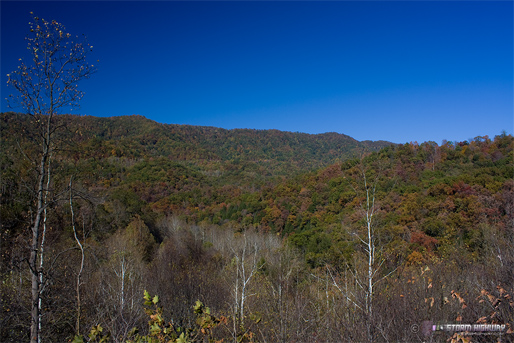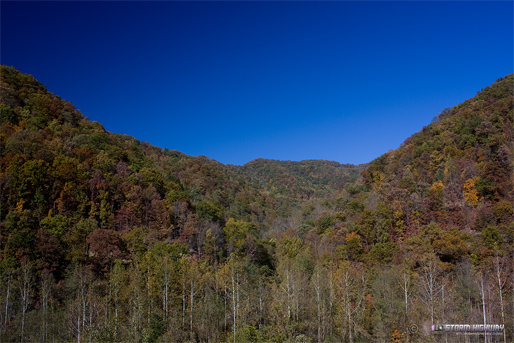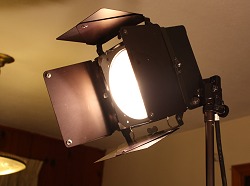|
In September of 2025, my work is generating the most income it ever has in my career. Yet, I'm being forced to shut down my successul operation, against my will, due to one cause alone: 95% of that revenue is being stolen by piracy and copyright infringement. I've lost more than $1 million to copyright infringement in the last 15 years, and it's finally brought an end to my professional storm chasing operation. Do not be misled by the lies of infringers, anti-copyright activists and organized piracy cartels. This page is a detailed, evidenced account of my battle I had to undertake to just barely stay in business, and eventually could not overcome. It's a problem faced by all of my colleagues and most other creators in the field. |
Clear skies dominated all day today, so once I got some work finished around 2PM, I decided to head out for another fall colors shoot. Satellite showed cirrus to the south inching our way, but its northern edge seemed to be evaporating all day down south of the VA/NC line. I called down to Big Walker to check up on the conditions there, then headed out the door. Unfortunately I only made it to Mossy before a mass of cirrus raced overhead in a matter of 20 minutes, ending the trip early. Colors here in the lower elevations near Charleston have been disappointing so far, pretty dull and unsaturated. Most trees are changing, but to bland shades of faded brown and red rather than classic bright colors. I'm not up on the science of fall foliage, so I'm not sure if this will improve since it is getting pretty late in the season. These two were the only scenes I got in before the cloud cover arrived, along the Paint Creek valley between Mossy and Mahan.

click to enlarge

click to enlarge
I want to get one more mountain foliage photography trip in before the leaves are finished. This may not be easy, as clear skies are going to be gone for at least a week or more as the big system approaches and arrives from the west. And that will be followed by a prolonged northwest upslope flow period that typically results in many consecutive days of overcast. The models do show a rather strong ridge forming in the wake of the upcoming system, which could bring us a couple of days of clear skies once its axis passes over. But that could be 10 or more days away, possibly enough time for any good leaf colors in the higher elevations to be long past.
Snow update
The GFS as of today's morning (12Z) run has wavered again in its outlook for Sunday-Thursday, not as cold and not as heavy on the precip. Still a good bet on snow in the mountains, which at this point seems like a certainty at some time early next week. The latest runs show Tuesday as the most potent snow day. Some wet snow or a brief mix looks likely for Charleston, but temps look way too warm for any road issues right now. That could always change, though. A potent, multi-day lake effect event off of Michigan and Erie is also indicated on the model output, the Michigan plume being the one that may affect the WV mountains the most as it is carried down and into the western slopes. If I had to make a forecast now, I'd say I'll be in Beckley Sunday and Monday night at the least. I'll probably start a running updates post for this storm on Saturday if it still looks like the event is a go.
Lighting: new softbox!
I ordered a second Photoflex softbox and speedring today for one of my Tota lights, which should arrive tomorrow. I'll hopefully get some practice time in with it this weekend. Since the Tota is a 750 watt fixture - much brighter than my softboxed 500 watt Omni - I am planning on putting a lower wattage bulb in the Omni softbox (maybe a 300 watt) and using it as a fill, while delegating the Tota softbox as the (brighter) key.
Why are pro lights necessary?
You may be wondering why I can't just use consumer incandescant or halogen light bulbs, lamps and/or inexpensive work lights for video projects. The reasons are that 1.) consumer lights are not color-balanced, 2.) they cannot be easily controlled (with filters and barn doors), and 3.) they are not built to safely handle the typical output of pro lights.
First and possibly most importantly, professional lights are precisely color-balanced to emit the same hue of light regardless of their wattage or brand. Color-balanced lights are manufactured to emit light at a certain 'color temperature' that is measured in degrees Kelvin (K). If you bought a 100 watt bulb and a 50 watt bulb at Wal-Mart, or even two different brands of the same wattage, they will emit two different color temperatures. By contrast, a professional 100 watt light will emit the exact same color temp as a 1000 watt light. Consumer bulbs are not manufactured with precise tolerances in color temperature output in mind. This means that even two identical light bulbs may emit slightly different color temperatures, enough to be noticeable on camera.
With consumer bulbs, lower wattage lights usually equal lower color temperatures. Lower color temperatures appear orange in comparison to a higher temperature values. Higher color temps appear blue in comparison. It's just like the color/temperature relationship of flames in a fire. So, if you have a bunch of different lights in a room (lamps, ceiling lights, etc), they most likely will be emitting different color temps.
 The human eye can usually adjust to view multiple color temps satisfactorily, but a camera can't. A camera has to be set at a specific color temperature (called a 'white balance' setting). If there are varying color temps in a scene, there will be unsightly blue or orange hues from light sources that are not matching the camera's white balance setting. You can see this in the photo at right. The hanging light fixture in the background is using a combination of common household CFLs and incandescents - and notice the orange/yellow cast it creates on the white wall and ceiling in comparison to the white 3200K light from the Omni. If you tried to mix those two color temps to illuminate the face of a person, the results would look very strange and unsightly.
The human eye can usually adjust to view multiple color temps satisfactorily, but a camera can't. A camera has to be set at a specific color temperature (called a 'white balance' setting). If there are varying color temps in a scene, there will be unsightly blue or orange hues from light sources that are not matching the camera's white balance setting. You can see this in the photo at right. The hanging light fixture in the background is using a combination of common household CFLs and incandescents - and notice the orange/yellow cast it creates on the white wall and ceiling in comparison to the white 3200K light from the Omni. If you tried to mix those two color temps to illuminate the face of a person, the results would look very strange and unsightly.
Professional lights are balanced at either 3200K (tungsten) or 5600K (natural daylight) so that all of the lights in a scene will match the camera's white balance setting. 5600K lights are usually either balanced fluorescent or HMI (arc) lights, both very expensive - but can be used in conjunction with natural daylight (as in outdoors or with light coming through windows). Tungsten is more popular, as it is less expensive and available in more versatile combinations. Blue filters (called 'gels') can even be applied to tungsten lights to make them match daylight. So far, all of my lights are 3200K tungsten units.
Second, most professional tungsten lights are high-wattage fixtures (500 watts and up), and as such they run very, very hot. This means they must be used in special fixtures built with materials that can safely withstand the heat output. Many types of work lights from a hardware store are usually rated for a 500 watt bulb max. Put a 750 watt or 1000 watt Tota bulb in a 500w work light (yes, they will fit) and it may melt or catch fire!
Third, pro lights are built to be controllable and versatile. You can easily attach filters, reflectors or softboxes to pro lights to modify their output depending on the needed application. Barn doors allow light spill to be controlled. Most professional lights are lightweight, making them easier to mount in various types of rigs (stands, frames, booms, etc). Some lights (like fresnel lights and the Omni pictured above) have a focusable beam. Consumer light fixtures have none of these benefits. Homemade controls can take more time and expense to create and build than simply buying a pro light.
And finally, when a client hires you and pays you as a pro, it's not a good thing to be showing up with stuff from Home Depot. If you hired a wedding photographer, you would not want him or her to show up with a pocket digital camera. Having the right tools for the job makes a difference. A beginner in this field will hear a lot of bad advice about how cheap consumer-grade lights can do what the pro lights do. Even I initially bought work lights thinking I could get by with them. In some situations, they can give OK results. But if you plan on making your results the best they can be - with color-balanced, safe and controllable light - pro lights definitely have the edge over homemade setups. One thing I learned in business is if someone is paying you, you have an obligation to make your product the best it can be by using the right tools and learning how to use them properly. So that's why I have nearly $1,500 in my light kit so far. And that's a modest number, as many seasoned freelancers have more than $10,000 in their lighting packages (full sets of softboxes, fresnels, fluorescents, HMIs, scrims, frames, etc).